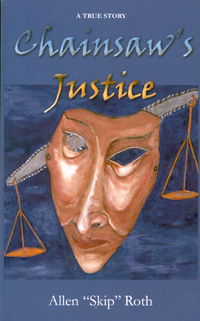
Chainsaw's Justice
Allen "Skip" Roth
Review by Alyce Wilson
Chainsaw's Justice is the autobiography of Allen "Skip" Roth, nicknamed "Chainsaw" for the tool he uses to carve his large, wooden sculptures. The autobiographical book focuses on the period of his life when Roth served time in prison after being found guilty of murder, a verdict later overturned when the incident was proven to be self-defense.
In the ancient Chinese proverb sense of the word, Roth has led an interesting life, a life of extremes, from national TV appearances for his artwork to local ignominy and the anonymity of prison.
The book begins by describing the circumstances that led to Roth's incarceration, an escalading feud with a neighbor who had molested his son. When that neighbor came after him and two family members with a gun raised, Roth shot to defend himself. However, due in part to an inept lawyer, he was found guilty in a court of law.
This part of the story is very detailed, reading almost as a court deposition. However, the ordinary reader finds it difficult to wade through everything and to visualize it. The overabundance of detail causes the events to run into each other, their import unclear.
After Roth is incarcerated, the book takes a turn as he describes in colorful, emotional detail the life inside prison. This is the real emotional meat of the story, and Roth's writing comes alive. He does a great job talking about the daily humiliations, challenges and dangers of living behind bars.
To close the book, Roth discusses the legal process of his appeal and his frustrations with incompetent and perhaps shady lawyers. Again, this part reads more like a weighty deposition, especially when combined with the vivid writing that immediately preceded it.
Sprinkled throughout the book, Roth gives detailed descriptions of his artwork and how it has developed over the years, talking about the fame he won for himself as a chainsaw artist. He's made numerous appearances on television, including one on "The Tonight Show," where he did a sculpture of Jay Leno. This part of the story is interesting but could be a separate book in itself.
Roth wrote this book, it seems, to record his side of the story because, according to his narrative, the local papers often sided with law enforcement. But as interesting as some passages are, it's hard to see how this would appeal to a general audience in its current form.
This book would benefit from a skilled editor or even a co-author who
could help Roth shape his story. Like his art, the secret to carving
is not just what the artist removes but what remains. Currently, this
work is like a solid block of wood, containing all the important events
in Roth's life to date. With some shaping, he could create an engaging
work that would tell his story in a meaningful way.
de Sitter Publications, 2005: ISBN 1-897160-13-5